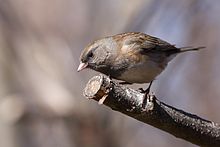| Juncos | |
|---|---|
 | |
| Slate-colored dark-eyed junco (Junco hyemalis hyemalis) female, Cap Tourmente National Wildlife Area, Quebec, Canada | |
| Scientific classification | |
| Kingdom: | Animalia |
| Phylum: | Chordata |
| Class: | Aves |
| Order: | Passeriformes |
| Family: | Passerellidae |
| Genus: | Junco Wagler, 1831 |
| Species | |
| Junco hyemalis | |
A junco /ˈdʒʌŋkoʊ/, genus Junco, is a small North American bird in the New World sparrow family Passerellidae. Junco systematics are still confusing after decades of research, with various authors accepting between three and twelve species. Despite having a name that appears to derive from the Spanish term for the plant genus Juncus (rushes), these birds are seldom found among rush plants, as these prefer wet ground, while juncos prefer dry soil.
Their breeding habitat is coniferous or mixed forest areas throughout North America, ranging from subarctic taiga to high-altitude mountain forests in Mexico and Central America south to Panama. Northern birds usually migrate farther south; southern populations are permanent residents or altitudinal migrants, moving only a short distance downslope to avoid severe winter weather in the mountains.
These birds forage on the ground. In winter, they often forage in flocks. They eat mainly insects and seeds. They usually nest in a well-hidden location on the ground or low in a shrub or tree.
Systematics
- Dark-eyed junco (Junco hyemalis)—the Latin name literally means winter junco, as the species was first described in southern North America, where the bird migrates to in the winter.
- Gray-headed dark-eyed junco (J. h. caniceps)—sometimes considered either a separate species (J. caniceps) or a separate species with two subspecies (also see fourth line below). Caniceps in Latin means gray-headed.
- Oregon dark-eyed juncos, J. h. oreganus subspecies group—sometimes considered a separate species (J. oreganus) with either seven or eight subspecies (also see third line below)
- Pink-sided dark-eyed junco (J. h. mearnsi)—sometimes included within the J. h. oreganus subspecies group
- Red-backed dark-eyed junco (J. h. dorsalis)—sometimes included within the J. h. caniceps subspecies group, or sometimes considered either a separate species (J. dorsalis) or a separate species (J. caniceps) with two subspecies (also see first line above)
- Slate-colored dark-eyed juncos, J. h. hyemalis subspecies group—sometimes considered a separate species with either two or three subspecies (one subspecies in this group, J. h. cismontanus, is possibly a hybrid between another subspecies in this group (J. h. hyemalis) and a subspecies in the oreganus subspecies group (J. h. oreganus))
- White-winged dark-eyed junco (J. h. aikeni)—sometimes considered a separate species
- Guadalupe junco, Junco insularis
- Yellow-eyed junco (Junco phaeonotus)
- Arizona yellow-eyed junco (J. p. palliatus)
- Mexican yellow-eyed junco (J. p. phaeonotus)
- Chiapas yellow-eyed junco (J. p. fulvescens)
- Guatemalan yellow-eyed junco (J. p. alticola)
- Baird's junco (Junco bairdi)
- Volcano junco (Junco vulcani)
